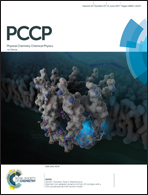Sigma-hole carbon-bonding interactions in carbon–carbon double bonds: an unnoticed contact†
Abstract
In this manuscript, we combine high-level ab initio calculations on some small complexes and a CSD survey to analyze the existence of unprecedented noncovalent carbon bonds in X2C![[double bond, length as m-dash]](https://www.rsc.org/images/entities/char_e001.gif) CH2⋯Y systems (Y = electron-rich atom or group). The methylene group is usually seen as a weak hydrogen bond donor when interacting with an electron-rich atom. However, we demonstrate that when the electron-rich atom is located equidistant from the two H atoms and along the C
CH2⋯Y systems (Y = electron-rich atom or group). The methylene group is usually seen as a weak hydrogen bond donor when interacting with an electron-rich atom. However, we demonstrate that when the electron-rich atom is located equidistant from the two H atoms and along the C![[double bond, length as m-dash]](https://www.rsc.org/images/entities/char_e001.gif) C bond a σ-hole noncovalent carbon-bonding interaction is established, instead of a bifurcated hydrogen bond, as derived from Atoms-in-Molecules (AIM) and Natural bond orbital (NBO) analyses. The physical nature of the interaction has been analyzed using the Symmetry Adapted Perturbation Theory (SAPT) method. The results indicate that electrostatics is very important followed by either the induction or dispersion terms in anionic and neutral complexes, respectively. In addition the CSD analysis reveals the existence of such interactions, giving reliability to our calculations, which are much more numerous for neutral than for anionic Y systems.
C bond a σ-hole noncovalent carbon-bonding interaction is established, instead of a bifurcated hydrogen bond, as derived from Atoms-in-Molecules (AIM) and Natural bond orbital (NBO) analyses. The physical nature of the interaction has been analyzed using the Symmetry Adapted Perturbation Theory (SAPT) method. The results indicate that electrostatics is very important followed by either the induction or dispersion terms in anionic and neutral complexes, respectively. In addition the CSD analysis reveals the existence of such interactions, giving reliability to our calculations, which are much more numerous for neutral than for anionic Y systems.



 Please wait while we load your content...
Please wait while we load your content...